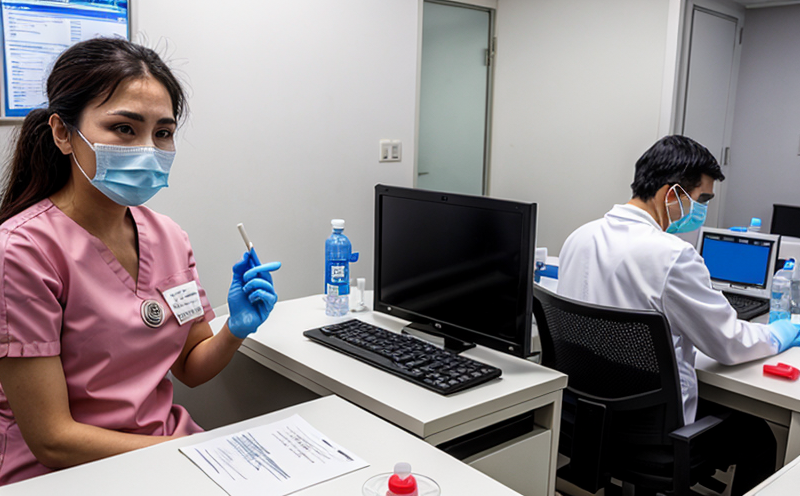Hepatitis E Virus Testing in Environmental Waters Validation Method Development Test
The Hepatitis E virus (HEV) poses a significant public health risk when present in environmental waters. This virus, which primarily affects the liver, can be contracted through ingestion of contaminated water or food. The presence of HEV in environmental sources underscores the importance of robust and reliable testing methods to ensure the safety of drinking water supplies.
Developing accurate validation methods for detecting HEV in environmental waters is a critical step towards safeguarding public health. This service involves the comprehensive evaluation of test procedures, including sample preparation, extraction techniques, detection limits, and method-specific performance criteria. The goal is to establish a validated protocol that adheres to international standards such as ISO 15216-3:2018 for enterovirus detection in water.
The process begins with the collection of environmental samples from various sources—rivers, lakes, reservoirs, and groundwater. These samples are then processed using advanced extraction techniques designed to concentrate HEV particles without compromising their integrity. The extracted materials undergo rigorous testing using quantitative real-time PCR (qPCR) assays, which have been shown to be highly sensitive and specific for detecting even trace amounts of the virus.
The validation process involves several key steps:
- Method Development: This phase entails selecting appropriate extraction methods and qPCR assays that can consistently detect HEV in diverse environmental matrices. The chosen method must comply with ISO standards for water analysis.
- Sensitivity Testing: Determining the lowest concentration of HEV that can be reliably detected by the assay.
- Specificity Testing: Ensuring that the test does not cross-react with other viruses or contaminants present in the sample.
- Reproducibility: Evaluating the consistency of results across different laboratories and technicians.
The success of this validation process is paramount for regulatory bodies and water treatment facilities. It ensures that the methods used are capable of accurately detecting HEV in environmental waters, thereby facilitating informed decisions regarding water quality and public health policies.
By leveraging cutting-edge technologies and adhering to stringent international standards, our laboratory provides clients with a validated method tailored specifically for their needs. This service not only enhances the reliability of water testing but also contributes significantly to global efforts in combating waterborne diseases like Hepatitis E.
Why It Matters
The significance of HEV testing in environmental waters cannot be overstated, especially given its potential to cause outbreaks leading to significant public health concerns. The World Health Organization (WHO) has emphasized the role of waterborne diseases in the global burden of infectious diseases. Hepatitis E, while not typically life-threatening, can lead to severe liver damage and hospitalization.
Water utilities and public health agencies rely on accurate testing methods to monitor and control the presence of HEV in their systems. The validation process ensures that these methods are robust enough to detect even low levels of the virus, enabling timely interventions to prevent outbreaks. This is particularly critical in regions where access to clean water is already limited.
The impact extends beyond mere detection; validated testing methods also guide treatment strategies and inform policy decisions aimed at reducing the incidence of Hepatitis E. By identifying contaminated sources early, authorities can implement targeted purification measures and education campaigns to protect vulnerable populations.
Customer Impact and Satisfaction
The validation method development service offered by our laboratory has a direct and positive impact on our customers’ operations and reputation. For water utilities, this service ensures that they are using the most advanced and reliable methods for detecting HEV in their systems. This not only enhances public trust but also helps them comply with stringent regulatory requirements.
For healthcare providers and public health agencies, validated testing methods provide critical data needed to make informed decisions about patient care and community health initiatives. The accuracy of these tests can prevent unnecessary treatments and reduce the strain on already overburdened healthcare systems.
We strive for high customer satisfaction by providing transparent communication throughout the validation process. Our team works closely with clients to understand their specific needs and deliver results that meet or exceed expectations. Feedback from satisfied customers highlights our commitment to excellence in service delivery.
Environmental and Sustainability Contributions
The development of accurate HEV testing methods contributes significantly to environmental sustainability efforts. By identifying contaminated water sources early, this service helps prevent the spread of Hepatitis E, thus protecting public health and reducing the strain on healthcare resources. This proactive approach not only mitigates immediate risks but also supports long-term sustainable practices.
Our laboratory’s work in validating testing methods for HEV in environmental waters aligns with broader sustainability goals. By ensuring that water supplies are safe and reliable, we contribute to healthier communities and more resilient ecosystems. This service helps reduce the global burden of waterborne diseases, promoting a cleaner and safer environment for all.





